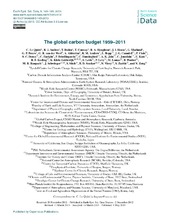| dc.description.abstract | Accurate assessments of anthropogenic carbon dioxide (CO2) emissions and their redistribution among the atmosphere, ocean, and terrestrial biosphere is important to better understand the global carbon cycle, support the climate policy process, and project future climate change. Present-day analysis requires the combination of a range of data, algorithms, statistics and model estimates and their interpretation by a broad scientific community. Here we describe datasets and a methodology developed by the global carbon cycle science community to quantify all major components of the global carbon budget, including their uncertainties. We discuss changes compared to previous estimates, consistency within and among components, and methodology and data limitations. CO2 emissions from fossil fuel combustion and cement production (EFF) are based on energy statistics, while emissions from Land-Use Change (ELUC), including deforestation, are based on combined evidence from land cover change data, fire activity in regions undergoing deforestation, and models. The global atmospheric CO2 concentration is measured directly and its rate of growth (GATM) is computed from the concentration. The mean ocean CO2 sink (SOCEAN) is based on observations from the 1990s, while the annual anomalies and trends are estimated with ocean models. Finally, the global residual terrestrial CO2 sink (SLAND) is estimated by the difference of the other terms. For the last decade available (2002–2011), EFF was 8.3 ± 0.4 PgC yr−1, ELUC 1.0 ± 0.5 PgC yr−1, GATM 4.3 ± 0.1PgC yr−1, SOCEAN 2.5 ± 0.5 PgC yr−1, and SLAND 2.6 ± 0.8 PgC yr−1. For year 2011 alone, EFF was 9.5 ± 0.5 PgC yr−1, 3.0 percent above 2010, reflecting a continued trend in these emissions; ELUC was 0.9 ± 0.5 PgC yr−1, approximately constant throughout the decade; GATM was 3.6 ± 0.2 PgC yr−1, SOCEAN was 2.7 ± 0.5 PgC yr−1, and SLAND was 4.1 ± 0.9 PgC yr−1. GATM was low in 2011 compared to the 2002–2011 average because of a high uptake by the land probably in response to natural climate variability associated to La Niña conditions in the Pacific Ocean. The global atmospheric CO2 concentration reached 391.31 ± 0.13 ppm at the end of year 2011. We estimate that EFF will have increased by 2.6% (1.9–3.5%) in 2012 based on projections of gross world product and recent changes in the carbon intensity of the economy. All uncertainties are reported as ±1 sigma (68% confidence assuming Gaussian error distributions that the real value lies within the given interval), reflecting the current capacity to characterise the annual estimates of each component of the global carbon budget. This paper is intended to provide a baseline to keep track of annual carbon budgets in the future. | en_US |

